Remarkable Reissues: The Man Who Lost His Head by Claire Huchet Bishop
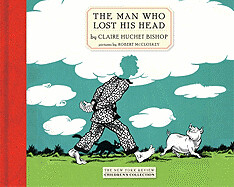
Children’s librarians have a sneaky tendency to become children’s authors. Tis the natural way of things. There comes a point when the average librarian starts to feel a tug on the old heartstrings, and an overwhelming desire to transition from telling other peoples’ stories to telling one’s own.
Here at New York Public Library we had a couple librarians succumb to the urge. Anne Carroll Moore, who essentially started the business, wrote a couple books in her time. Pura Belpre not only told her own stories and had them printed but got a Medal named after her and a picture book written about her after the fact. In the Children’s Center where I now work the librarian/author/illustrator Marcia Brown not only wrote Cinderella and Stone Soup (amongst others) but also managed to garner a Caldecott or two in the process.
ADVERTISEMENT
ADVERTISEMENT
And then there was Claire Huchet Bishop. She also worked in my room, though not before being born in France, attending the Sorbonne, and founding France’s first library for kids, L’Heure Joyeuse. Then, as countless French women are apt to do, she married an American pianist and worked at NYPL. During her lifetime she wrote a number of picture books, her most famous probably being 1938’s The Five Chinese Brothers.
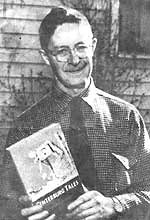 But in 1942 she wrote a very different story. It was called The Man Who Lost His Head and its illustrator was one Robert McCloskey. Yup. In 1941 he had just wowed the world with Make Way for Ducklings, and then Ms. Bishop gets his work on her own book right after that. Lucky lady, no?
But in 1942 she wrote a very different story. It was called The Man Who Lost His Head and its illustrator was one Robert McCloskey. Yup. In 1941 he had just wowed the world with Make Way for Ducklings, and then Ms. Bishop gets his work on her own book right after that. Lucky lady, no?
I am happy to report that The New York Review Children’s Collection is coming out with a reissued copy of The Man Who Lost His Head. Out-of-print for over twenty-five years, this December you’ll be able to purchase a fine hardcover copy of the book yourself.
Now truth be told I was unfamiliar with this story before NYRB sent me a copy for my perusal. I flipped it open and enjoyed it from beginning to end. Except… something strange happened to me as I read it. I must have realized that McCloskey was the artist from the start. I mean, it’s right there on the cover. But as I paged through and enjoyed what I read, my brain slowly and surely grew convinced that the artist working on this book was Robert Lawson. In fact, if you had stopped me midway through and told me that this was by Robert McCloskey I would have socked you in the jaw. Well… okay, that’s a bit extreme. I certainly would have sneered, though. Oh, the sneering there would be from me. How my lip would curl. I’d give you a patronizing little pat on the head and inform you that I’m pretty sure I know my Lawson from my McCloskey. You could probably counter this by asking whether or  not it’s true that I had to look up The Story of Ferdinand to figure out if the illustrator was Lawson or Monroe Leaf? At which point I would shut up and then, presumably, notice that the artist on this particular book is McCloskey after all.
not it’s true that I had to look up The Story of Ferdinand to figure out if the illustrator was Lawson or Monroe Leaf? At which point I would shut up and then, presumably, notice that the artist on this particular book is McCloskey after all.
I don’t know why I didn’t recognize McCloskey’s work. If I think in terms of Make Way for Ducklings or A Time of Wonder then yes. His style is very different from what one finds in the thin pen-and-inks of The Man Who Lost His Head. But if you remember that McCloskey also did the illustrations for his Homer Price books, then the styles are identical.
ADVERTISEMENT
ADVERTISEMENT
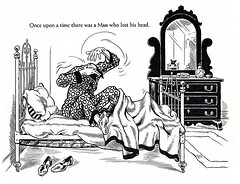 In the case of this particular book, McCloskey’s work is half the joy. The story concerns a man who wakes up one day to discover that he has misplaced his noggin. Somewhat perturbed he decides to retrace his steps and go back to the fair where he lost it. To do so, however, he attempts to walk with a pumpkin head, a parsnip head, and a carved wooden head respectively. The wooden head is the most successful, but when he has an unfortunate run in with a tiger, he feels pretty low. Fortunately a boy takes him at his word about the whole I’m-missing-my-head problem, demanding a full description of the head that’s been lost. When he hears it all, the boy determines that only drastic measures will bring the head back. Drastic measures that, surprisingly, work.
In the case of this particular book, McCloskey’s work is half the joy. The story concerns a man who wakes up one day to discover that he has misplaced his noggin. Somewhat perturbed he decides to retrace his steps and go back to the fair where he lost it. To do so, however, he attempts to walk with a pumpkin head, a parsnip head, and a carved wooden head respectively. The wooden head is the most successful, but when he has an unfortunate run in with a tiger, he feels pretty low. Fortunately a boy takes him at his word about the whole I’m-missing-my-head problem, demanding a full description of the head that’s been lost. When he hears it all, the boy determines that only drastic measures will bring the head back. Drastic measures that, surprisingly, work.
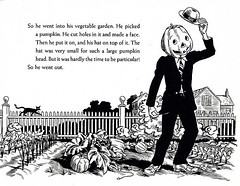 Truth be told, the story’s pretty wacky. Head loss happens in children’s literature on occasion, but there are only so many things you can do with it. I sometimes think of the Headless Horseman portions of Adam Rex’s Frankenstein Takes the Cake as being the best possible series of solutions to a headless problem. Little did Mr. Rex know that he was merely following in the footsteps of the greats when he came up with the problems of pumpkin headery. Bishop’s tale is too long for a storytime readaloud, I think, but for one-on-one reading it’s ideal. A bit wacky and surreal, sure. But there’s plenty to enjoy here.
Truth be told, the story’s pretty wacky. Head loss happens in children’s literature on occasion, but there are only so many things you can do with it. I sometimes think of the Headless Horseman portions of Adam Rex’s Frankenstein Takes the Cake as being the best possible series of solutions to a headless problem. Little did Mr. Rex know that he was merely following in the footsteps of the greats when he came up with the problems of pumpkin headery. Bishop’s tale is too long for a storytime readaloud, I think, but for one-on-one reading it’s ideal. A bit wacky and surreal, sure. But there’s plenty to enjoy here.
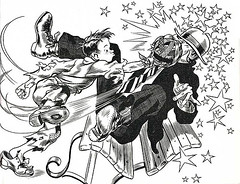 For me, the book’s greatest lure is its art. The book is entirely black and white, drawn with pen-and-ink illustrations of incredible detail. I love the moment when the pictures illustrate the idea of "average ears" by showing seven different ears at the top of the page, and then those ears are divided by seven in a math equation at the bottom, leaving a single "average" earlobe. The book fairly reeks of its time period too. I don’t think McCloskey gets enough credit for his shoes. The man drew really wonderful men’s shoes. Small gestures too. There’s a moment where the man is sitting on the bench listening to the boy. He rests his wooden head on the fist of one hand, but the other hand sits on the bench next to him, palm open and inward, the weight distributed entirely on the knuckles. It’s the most casual pose in the world, but I’ve never seen it replicated in a children’s book before.
For me, the book’s greatest lure is its art. The book is entirely black and white, drawn with pen-and-ink illustrations of incredible detail. I love the moment when the pictures illustrate the idea of "average ears" by showing seven different ears at the top of the page, and then those ears are divided by seven in a math equation at the bottom, leaving a single "average" earlobe. The book fairly reeks of its time period too. I don’t think McCloskey gets enough credit for his shoes. The man drew really wonderful men’s shoes. Small gestures too. There’s a moment where the man is sitting on the bench listening to the boy. He rests his wooden head on the fist of one hand, but the other hand sits on the bench next to him, palm open and inward, the weight distributed entirely on the knuckles. It’s the most casual pose in the world, but I’ve never seen it replicated in a children’s book before.
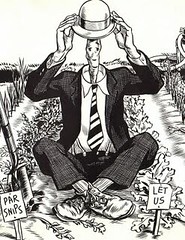 It’s always a pleasure when a book is rereleased, but it’s a particular pleasure when that same book has such an illustrious pedigree. The Bishop/McCloskey pairing didn’t happen very often, but we can sure be glad that it did with this hidden treasure. If you’ve an original at your library, check it out. If not, wait until December ’09 and you’ll be able to see it for yourself.
It’s always a pleasure when a book is rereleased, but it’s a particular pleasure when that same book has such an illustrious pedigree. The Bishop/McCloskey pairing didn’t happen very often, but we can sure be glad that it did with this hidden treasure. If you’ve an original at your library, check it out. If not, wait until December ’09 and you’ll be able to see it for yourself.
Be sure to also read an old post on the book at Vintage Kids’ Books My Kid Loves.
Source: Copy sent by publisher.
Filed under: Uncategorized
About Betsy Bird
Betsy Bird is currently the Collection Development Manager of the Evanston Public Library system and a former Materials Specialist for New York Public Library. She has served on Newbery, written for Horn Book, and has done other lovely little things that she'd love to tell you about but that she's sure you'd find more interesting to hear of in person. Her opinions are her own and do not reflect those of EPL, SLJ, or any of the other acronyms you might be able to name. Follow her on Twitter: @fuseeight.
ADVERTISEMENT
ADVERTISEMENT
SLJ Blog Network
2024 Books from Coretta Scott King Winners
Double Booking | This Week’s Comics
Parsing Religion in Public Schools
The Tortured Poets Department Poetry Party Part 2: DIY Frames for Your Instant Photos
ADVERTISEMENT




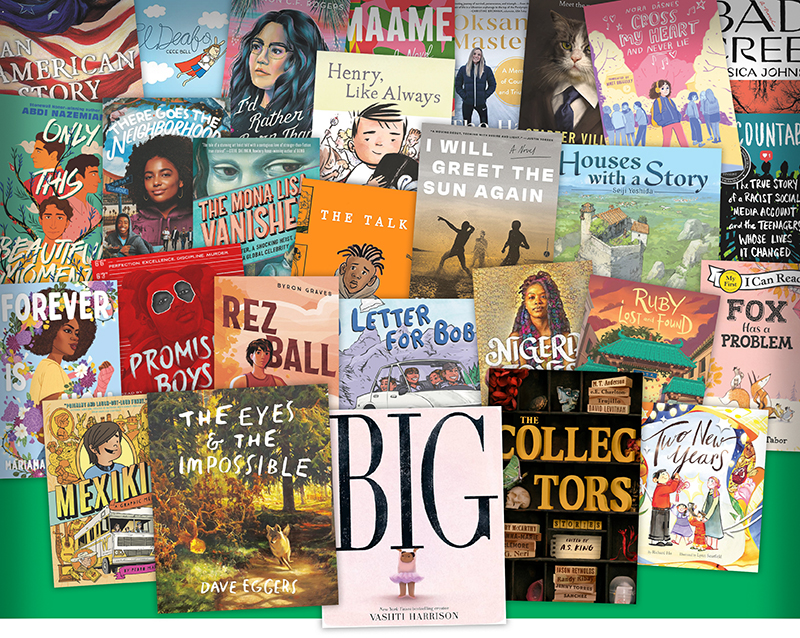



Elizabeth, you’ll be happy to know that Sara Kramer, the book’s editor at NYRB, will be speaking at our 11/18 PEN Children’s Book meeting. Please come! (Any other PEN members or future ones are welcome to attend.)
Editorial Anonymous also had a head-loss-themed discussion recently (“Reissuing a Classic… or not”). Must be something in the air this fall…
Thanks for providing the publishing history of authors who worked at NYPL. To add to those you mentioned, Augusta Baker with her wonderful tales for storytelling and myself, with SAM PATCH: DAREDEVIL JUMPER published this year by Holiday House. THE MAN WHO LOST HIS HEAD is a wonderful, even though old, story.It’s time to bring back more this old goodies.
Julie Cummins
Just ordered this for the store yesterday—can’t wait!
Excellent reminder, Julie! And I guess I forgot that Augusta Baker did fiction as well as non-fiction. Who knew! Now I need to find that “Sam Patch”.
This book carries a powerful wallop–it’s my strongest reading memory from very early childhood. Be warned! Read this to a child and she may never forget it (and grow up to be a children’s book writer.)
Cool, I love the old books, always great to see them brought back. This title joins the great tradition of Kafka’s “Metamorphosis” (though I suppose Ovid deserves some credit, too) — “Imogene’s Antlers,” there’s another — when a character wakes up transformed. It’s a rich mine and artists go back to it time and again.
And Betsy, I totally get how you enjoy that great tradition of librarian/authors. I felt the same way when I worked on book clubs at Scholastic as a junior copywriter ($11,500 my first year, 1986!). So many good writers got their start there, steeped in those books, how could it not inform you, fill you up, and flow through. Standing on the shoulders of giants.